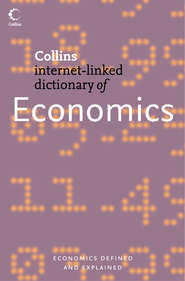
Полная версия:
Economics
(a) BARTER: the direct exchange of product for product;
(b) compensation deal: where the seller from the exporting country receives part payment in his own currency and the remainder in goods supplied by the buyer;
(c) buyback: where the seller of plant and equipment from the exporting country agrees to accept some of the goods produced by that plant and equipment in the importing country as part payment;
(d) counterpurchase: where the seller from the exporting country receives part payment for the goods in his own currency and the remainder in the local currency of the buyer, the latter then being used to purchase other products in the buyer’s country. See EXPORTING.
countervailing duty a TAX levied on an imported product (see IMPORTS) that raises the price in the domestic market as a means of counteracting ‘unfair’ trading practices by other countries. Countervailing duties are frequently employed against imported products that are deliberately ‘dumped’ (see DUMPING) or subsidized by EXPORT INCENTIVES. See TARIFF, IMPORT DUTY, BEGGAR-MY-NEIGHBOUR POLICY.
countervailing power the ability of large buyers to offset the market power of huge suppliers as in BILATERAL OLIGOPOLY. Large buyers usually have the upper hand in a vertical market chain (for example, multiple retailers buying from food manufacturers) because, unless suppliers collude (see COLLUSION), a large buyer is able to play one supplier off against another and obtain favourable discounts on bulk purchases. Provided that competition is strong in final selling markets, countervailing power can play an important role in checking monopolistic abuse.
The economist J. K. GALBRAITH uses the phrase ‘countervailing power’ in a slightly different way to refer to the growth of trade unions and consumer groups in response to the growth of large firms.
coupon 1 a document that shows proof of legal ownership of a FINANCIAL SECURITY and entitlement to payments thereon; for example, a SHARE certificate or BEARER BOND certificate.
2 a means of promoting the sale of a product by offering buyers of the product coupons that can be redeemed for cash, gifts or other goods.
coupon interest rate the INTEREST RATE payable on the face value of a BOND. For example, a £100 bond with a 5% coupon rate of interest would generate a nominal return of £5 per year. See EFFECTIVE INTEREST RATE.
Cournot, Augustin (1801–77) a French economist who explored the problems of price in conditions of competition and monopoly in his book The Mathematical Principles of the Theory of Wealth (1838). Cournot concentrated attention on the exchange values of products rather than their utilities, and he used mathematics to explore the relationship between the sale price of products and their costs, developing the idea of a MONOPOLY price. Cournot is also known for his work on DUOPOLY, his analysis showing that two firms would react to one another’s output changes until they eventually reached a stable output position from which neither would wish to depart.
covenant a specific condition in a legal agreement or CONTRACT. For instance, a formal agreement between a COMMERCIAL BANK and a JOINT-STOCK COMPANY to which it is loaning money might contain a covenant stipulating a limit on dividend distributions from profits.
covered interest arbitrage the borrowing and investing of foreign currencies to take advantage of differences in INTEREST RATES between countries. For example, a company could borrow an amount of one currency (say, the UK pound (£)), convert this into another currency (say, the US dollar ($)) and invest the proceeds in the USA. Concurrently, the company would sell $s for £s in the FUTURES MARKET for delivery at a future specified date. The company would earn a profit on such a transaction if the rate of return on its investment in the USA were greater than the combined expenses of interest payments on the amount of £s borrowed and the costs of concluding the forward exchange contract. Covered interest ARBITRAGE takes advantage of (and in the process tends to eliminate) any temporary discrepancies between relative interest rates in two countries and the forward exchange rate of the two countries’ currencies. See INTERNATIONAL FISHER EFFECT.
covering a means of protecting the domestic currency value of the future proceeds of an international trade transaction, usually by buying or selling the proceeds of the transaction in the FUTURES MARKET for foreign currencies.
CPI see CONSUMER PRICE INDEX.
crawling-peg exchange-rate system a form of FIXED EXCHANGE-RATE SYSTEM in which the EXCHANGE RATES between currencies are fixed (pegged) at particular values (for example £1 = $2) but which are changed frequently (weekly or monthly) by small amounts to new fixed values to reflect underlying changes in the FOREIGN EXCHANGE MARKETS: for example, £1 = $1.90 cents, the repegging of the pound at a lower dollar value (DEVALUATION), or £1 = $2.10 cents, the repegging of the pound at a higher dollar value (REVALUATION).
creative destruction see SCHUMPETER.
credibility 1 the extent to which individuals and firms believe that the government will carry out the macro-economic policies that it promises to pursue. Credibility is important in influencing the EXPECTATIONS that individuals and firms have about future economic policies, and these expectations in turn affect their current behaviour. 2 the extent to which potential market entrants believe that incumbent firms will react to their entry, for example, by cutting their prices. The credibility of such threats by incumbent firms will determine whether potential entrants decide to enter a market. See BARRIERS TO ENTRY, LIMIT PRICING, POTENTIAL ENTRANT.
credit a financial facility that enables a person or business to borrow MONEY to purchase (i.e. take immediate possession of) products, raw materials and components, etc., and to pay for them over an extended time period. Credit facilities come in a variety of forms, including BANK LOANS and OVERDRAFTS, INSTALMENT CREDIT, CREDIT CARDS and TRADE CREDIT. Interest charges on credit may be fixed or variable according to the type of facilities offered or, in some cases, ‘interest-free’ as a means of stimulating business.
In many countries CREDIT CONTROLS are used as an instrument of MONETARY POLICY, with the authorities controlling both the availability and terms of credit transactions. See CONSUMER CREDIT ACT 1974, INTEREST RATE.
credit card a plastic card or token used to finance the purchase of products by gaining point-of-sale CREDIT. Credit cards are issued by commercial banks, hotel chains and larger retailers. See EFTPOS.
credit controls 1 the regulation of borrowing from the FINANCIAL SYSTEM as part of MONETARY POLICY. OPEN MARKET OPERATIONS are one general means of limiting the expansion of credit. A more selective form of control is consumer INSTALMENT CREDIT regulation (hire purchase). Under this arrangement, the purchase of certain goods is regulated by the authorities stipulating the minimum down-payment and the maximum period of repayment.
2 the control that a firm exercises over its TRADE DEBTORS in order to ensure that customers pay their DEBTS promptly and to minimize the risk of bad debts. The purpose of credit control is to minimize the funds that a firm has to tie up in debtors, so improving profitability and LIQUIDITY. See FACTORING, WORKING CAPITAL.
credit creation see BANK-DEPOSIT CREATION.
creditor a person or business that is owed money by an individual or firm for goods, services or raw materials that they have supplied but for which they have not yet been paid (trade creditors) or because they have made LOANS. Creditors are also termed ‘accounts payable’. See DEBTORS, CREDIT.
creditor nation a country that has invested more abroad than has been invested internally. A creditor nation receives more interest and dividends on its investments abroad than it has to pay out on investments made in the country, with a consequent surplus on its BALANCE OF PAYMENTS. Many DEVELOPED COUNTRIES are creditor countries. Compare DEBTOR COUNTRY.
credit squeeze any action taken by the monetary authorities to reduce the amount of CREDIT granted by COMMERCIAL BANKS, FINANCE HOUSES, etc. Such action forms part of the government’s MONETARY POLICY directed towards reducing AGGREGATE DEMAND by making less credit available and forcing up INTEREST RATES.
creeping inflation small increases in the general level of prices in an economy. See INFLATION, HYPERINFLATION.
Crest see SHARE PURCHASE/SALE.
cross-elasticity of demand a measure of the degree of responsiveness of the DEMAND for one good to a given change in the PRICE of some other good.
(i) cross-elasticity of demand =

Products may be regarded by consumers as substitutes for one another, in which case a rise in the price of good B (tea, for example) will tend to increase the quantity demanded of good A (coffee, for example). Here the cross-elasticity of demand will be positive since as the price of B goes up the quantity demanded of A rises as consumers now buy more A in preference to the more expensive B.
(ii) cross-elasticity of demand =

Alternatively, products may be regarded by consumers as complements that are jointly demanded, in which case a rise in the price of good B (tea, for example) will tend to decrease not only the quantity demanded of good B but also another good, C (sugar, for example). Here the cross-elasticity of demand will be negative since a rise in the price of B serves to reduce the quantity demanded of C.
The degree of substitutability between products is reflected in the magnitude of the cross-elasticity measure. If a small increase in the price of good B results in a large rise in the quantity demanded of good A (highly cross-elastic), then goods B and A are close substitutes. Likewise, the degree of complementarity of products is reflected in the magnitude of the cross-elasticity measure. If a small increase in the price of good B results in a large fall in the quantity demanded of good C (highly cross-elastic), then goods C and B are close complements.
Cross-elasticities provide a useful indication of the substitutability of products, so helping to indicate the boundaries between markets. A group of products with high cross-elasticities of demand constitutes a distinct market, whether or not they share common technical characteristics; for example, mechanical and electronic watches are regarded by consumers as close substitutes. See MARKET.
cross-sectional data information gathered for the same period of time that is split into certain groupings based upon characteristics such as age, income, etc. Compare TIME SERIES DATA.
cross-subsidization the practice by firms of offering internal subsidies to certain products or departments within the firm financed from the profits generated by other products or departments. Cross-subsidization is often used by diversified and vertically integrated firms as a means of financing new product development; DIVERSIFICATION into new areas; or to facilitate price cuts to match intense competition in certain of its markets. See VERTICAL INTEGRATION, PRICE-SQUEEZE.
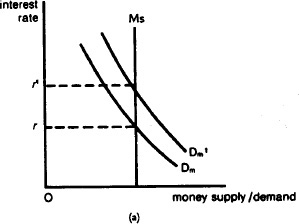
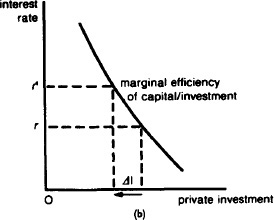
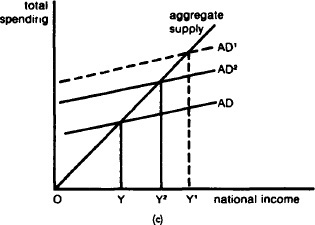
Fig. 34 Crowding-out effect. (a) An increase in government expenditure raises real NATIONAL INCOME and output (see EQUILIBRIUM LEVEL OF NATIONAL INCOME), which in turn increases the demand for money from Dm to Dm1, with which to purchase the greater volume of goods and services being produced. (b) This causes the equilibrium INTEREST RATE to rise (from r to r1), which then reduces – ‘crowds out’ – an amount of private INVESTMENT (ΔT). (c) An increase in government expenditure by itself would increase AGGREGATE DEMAND from AD to AD1, but, allowing for the fall in private investment, the net result is to increase aggregate demand to only AD2.
crowding-out effect an increase in GOVERNMENT EXPENDITURE that has the effect of reducing the level of private sector spending. Financial crowding-out of the type described in the captions to Fig. 34 would occur only to the extent that the MONEY SUPPLY is fixed, so that additional loanable funds are not forthcoming to finance the government’s additional expenditure. If money supply is fixed, then increases in the PUBLIC SECTOR BORROWING REQUIREMENT associated with additional government expenditure will tend to increase interest rates as the government borrows more, these higher interest rates serving to discourage private sector investment. On the other hand, if additional loanable funds were obtainable from, say, abroad, then additional government borrowing could be financed with little increase in interest rates or effect on private investment.
The term ‘crowding-out’ is also used in a broader sense to denote the effect of larger government expenditure in pre-empting national resources, leaving less for private consumption spending, private sector investment and for exports. Such real crowding-out would occur only to the extent that total national resources are fixed and fully employed so that expansion in public sector claims on resources contract the amount left for the private sector. Where unemployed resources can be brought into use, additional claims by both the public and private sectors can be met. See MONEY-SUPPLY/SPENDING LINKAGES, MARGINAL EFFICIENCY OF CAPITAL/INVESTMENT.
cum dividend adj. (of a particular SHARE) including the right to receive the DIVIDEND that attaches to the share. If shares are purchased on the STOCK EXCHANGE cum. div., the purchaser would be entitled to the dividend accruing to that share when the dividend is next paid. Compare EX DIVIDEND.
currency the BANK NOTES and coins issued by the monetary authorities that form part of an economy’s MONEY SUPPLY. The term ‘currency’ is often used interchangeably with the term cash in economic analysis and monetary policy.
currency appreciation see APPRECIATION 1.
currency depreciation see DEPRECIATION 1.
currency matching see EXCHANGE RATE EXPOSURE.
currency swap see SWAP.
current account 1 a statement of a country’s trade in goods (visibles) and services (invisibles) with the rest of the world over a particular period of time. See BALANCE OF PAYMENTS.
2 an individual’s or company’s account at a COMMERCIAL BANK or BUILDING SOCIETY into which the customer can deposit cash or cheques and make withdrawals on demand on a day-to-day basis. Current accounts (or sight deposits as they are often called) offer customers immediate liquidity with which to finance their transactions. Most banks and building societies pay INTEREST on current account balances that are in credit. See BANK DEPOSIT, DEPOSIT ACCOUNT.
current assets ASSETS, such as STOCKS, money owed by DEBTORS, and cash, that are held for short-term conversion within a firm as raw materials are bought, made up, sold as finished goods and eventually paid for. See FIXED ASSETS, WORKING CAPITAL.
current liabilities all obligations to pay out cash at some date in the near future, including amounts that a firm owes to trade CREDITORS and BANK LOANS/OVERDRAFTS. See WORKING CAPITAL.
current yield see YIELD.
Customs and Excise a government agency for the collection of INDIRECT TAXES levied in accordance with appropriate rates, rules and regulations. In the UK, Her Majesty’s Customs and Excise typically collects revenue from VALUE-ADDED TAX and EXCISE DUTY payable on alcoholic drink, tobacco and betting. The agency also enforces the laws regarding the import and export of certain goods, collects IMPORT DUTIES and seeks to prevent attempts to avoid paying import duties by smuggling. See also INLAND REVENUE.
customs duty a TAX levied on imported products (see IMPORTS). Unlike TARIFFS, customs duties are used primarily as a means of raising revenue for the government rather than as a means of protecting domestic producers from foreign competition. See TAXATION.
customs union a form of TRADE INTEGRATION between a number of countries in which members eliminate all trade barriers (TARIFFS, etc.) amongst themselves on goods and services, and establish a uniform set of barriers against trade with the rest of the world, in particular a common external tariff. The aim of a customs union is to secure the benefits of international SPECIALIZATION AND INTERNATIONAL TRADE, thereby improving members’ real living standards. See GAINS FROM TRADE, TRADE CREATION, EUROPEAN UNION, MERCOSUR.
cyclical fluctuation the short-term movements, both upwards and downwards, in some economic variable around a long-term SECULAR TREND line. See Fig. 35. See DEMAND MANAGEMENT.
cyclically adjusted public-sector borrowing requirement see PUBLIC-SECTOR BORROWING REQUIREMENT.
cyclical unemployment the demand-deficient UNEMPLOYMENT that occurs as a result of a fall in the level of AGGREGATE DEMAND and business activity during the RECESSION and DEPRESSION phases of the BUSINESS CYCLE.
cyclical variation see TIME-SERIES ANALYSIS.
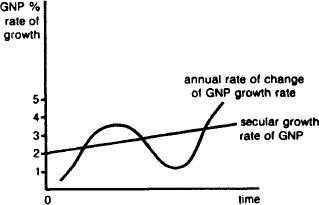
Fig. 35 Cyclical fluctuation. The pronounced short-term swings in output growth rates over the course of the BUSINESS CYCLE, around a rising long-term trend growth line for the country’s GROSS NATIONAL PRODUCT.
d
dawn raid a situation in which a potential TAKEOVER bidder for a company buys a substantial shareholding in the target company at current market prices, often through intermediaries (to disguise the identity of the bidder). This shareholding can then be used as a platform for a full takeover bid for all the shares at a stated offer price. See TAKEOVER BID, CITY CODE.
deadweight loss the reduction in CONSUMERS’ SURPLUS and PRODUCERS’ SURPLUS that results when the output of a product is restricted to less than the optimum efficient level that would prevail under PERFECT COMPETITION. Fig. 36 shows the demand and supply curves for a product, and their interaction establishes the equilibrium market price OP. At this price, consumers’ surplus is shown as the diagonally shaded area ABP and producers’ surplus as the vertically shaded area APO. If output is restricted from OQ to OQ1, then the price paid by consumers would rise to OP1 and consumers’ surplus would be reduced by the amount ACE, while the price received by producers would fall to OP2 and producers’ surplus would be reduced by the amount ADE.
Deadweight loss is particularly likely to occur in markets dominated by MONOPOLY suppliers who restrict output in order to keep prices high.
dear money see TIGHT MONEY.
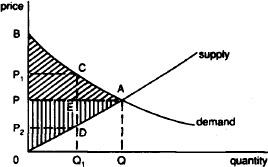
Fig. 36 Deadweight loss. See entry.
death rate the number of people in a POPULATION who die per thousand per year. In 2004, for example, the UK death rate was 10 people per 1,000 of the population. The difference between this rate and the BIRTH RATE is used to calculate the rate of growth of the population of a country over time. The death rate tends to decline as a country attains higher levels of economic development. See DEMOGRAPHIC TRANSITION.
debentures a means of financing companies through fixed-interest LOANS secured against company ASSETS.
In some cases the company may offer a specific asset, such as a particular machine, as security for the loan; in other cases lenders are offered security by means of a general claim against all company assets in the event of default. See LOAN CAPITAL.
debt an amount of money owed by a person, firm or government (the borrower) to a lender. Debts arise when individuals, etc., spend more than their current income or when they deliberately plan to borrow money to purchase specific goods, services or ASSETS (houses, financial securities, etc.). Debt contracts provide for the eventual repayment of the sum borrowed and include INTEREST charges for the duration of the loan. An individual’s debt can include MORTGAGES, INSTALMENT CREDIT, BANK LOANS and OVERDRAFTS; a firm’s debt can include fixed-interest DEBENTURES, LOANS, BILLS OF EXCHANGE and bank loans and overdrafts; a government’s debt can take the form of long-term BONDS and short-term TREASURY BILLS (see NATIONAL DEBT). See PUBLIC SECTOR BORROWING REQUIREMENT. See also INTERNATIONAL DEBT.
debt capital see LOAN CAPITAL.
debt financing the financing of firms’ and governments’ deficits by the issue of FINANCIAL SECURITIES such as short-dated company BILLS OF EXCHANGE and government TREASURY BILLS, and, in the case of government, longer-term BONDS. See PUBLIC SECTOR BORROWING REQUIREMENT.
debtor a person or business that owes money to individuals or firms for goods, services or raw materials that they have bought but for which they have not yet paid (trade debtors) or because they have borrowed money. Debtors are also termed ‘accounts receivable’. See CREDITORS, DEBT, CREDIT CONTROL, WORKING CAPITAL, BAD DEBT.
debtor nation a country that has had more invested in it than it has invested abroad. A debtor nation has to pay out more interest and dividends on investments made in the country than it receives, with a consequent deficit in its BALANCE OF PAYMENTS. Many DEVELOPING COUNTRIES are debtor nations. Compare CREDITOR COUNTRY.
debt servicing the cost of meeting INTEREST payments and regular contractual repayments of principal on a LOAN along with any administration charges borne by the BORROWER.
decentralization the diffusion of economic decision-making to many different decision-makers rather than concentrating such decision-making centrally. In an economy this is achieved by the adoption of the PRICE SYSTEM, which devolves decisions to individual consumers and suppliers. In a firm, decentralization involves delegating authority to make decisions ‘down the line’ to particular divisions and departments. See PRIVATE ENTERPRISE ECONOMY, M-FORM ORGANIZATION.
decision tree a graphical representation of the decision-making process in relation to a particular economic decision. The decision tree illustrates the possibilities open to the decision-maker in choosing between alternative strategies. It is possible to specify the financial consequence of each ‘branch’ of the decision tree and to gauge the PROBABILITY of particular events occurring that might affect the consequences of the decisions made. See RISK AND UNCERTAINTY.
decreasing returns to scale see DISECONOMIES OF SCALE.



